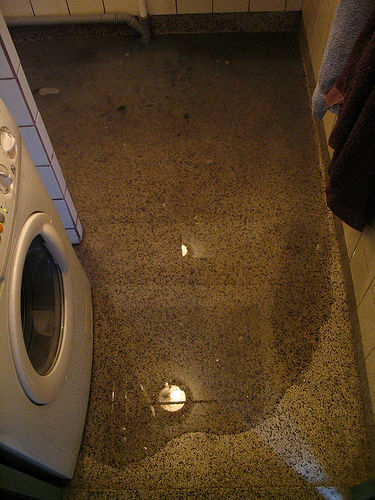
Utility drains are the drains in garages, laundry rooms, basements, and outdoor areas. Most of these areas will have drainage of some form, the most common being a basic drain in the floor leading to the wastewater line for the house.
Sinks in utility areas are often different than those found in kitchens and bathrooms. Utility sinks in most homes are deeper basins with a separate stopper plug, unlike bathroom lavatory basins. Laundry sinks also usually lack a disposal unit as you find attached to many kitchen sinks. Some utility sink setups even forgo the standard U-trap, and instead dump into or near a floor drain nearby. This may sound crude, but in areas where the floor is easily and frequently washed, catching and collecting all the waste matter that is rinsed down the sink can prevent larger problems from arising.
Outdoor drains, such as found on patio surfaces, will be different than indoor floor drains, and need to be maintained to remain clear of obstructions. In all drains meant to prevent flooding & damage from water backup, regular checking for proper function is crucial, but drains in outdoor pool areas are vulnerable to leaves or other debris.
 PermaFLOW Never-Clog DrainNever hassle with the tassle again.
PermaFLOW Never-Clog DrainNever hassle with the tassle again.
 BAAM! Drain Blaster CleanerWorks on sinks, tubs, and toilets. Reusable, environmentally friendly, and easy to use.
BAAM! Drain Blaster CleanerWorks on sinks, tubs, and toilets. Reusable, environmentally friendly, and easy to use.
 Enzytabs Septic Tank System TreatmentHELPS PREVENT SEPTIC BACKUPS: Effectively degrading grease. REDUCES BAD ODORS: Continuously breaking down the odorous volatile fatty acids.
Enzytabs Septic Tank System TreatmentHELPS PREVENT SEPTIC BACKUPS: Effectively degrading grease. REDUCES BAD ODORS: Continuously breaking down the odorous volatile fatty acids.
Step-by-step instructions for making quick work of clogged or slowly flowing bathroom sink drains
UncloggingDrains101.comStep-by-step instructions for making quick work of clogged or slowly flowing bathroom sink drains
UncloggingDrains101.comWhen you have a toilet plunger, you are well prepared for clearing clogs made up of anything softer than a rubber ducky.
UncloggingDrains101.comDeciding when it is time to call in a professional, and tips for selecting the right drain service
UncloggingDrains101.comWhich Household Drain Problems Can Be Handled Without Calling A Pro?
UncloggingDrains101.comWhen clogs form in bathroom sinks, showers, bathtubs, kitchen & utility sinks, or shop & laundry drains—then the preferred tool will be a drain auger.
UncloggingDrains101.comSolve your clogged toilet problem today--Learn to unblock a toilet using a plunger, using a toilet snake, or using whatever is handy!
UncloggingDrains101.com